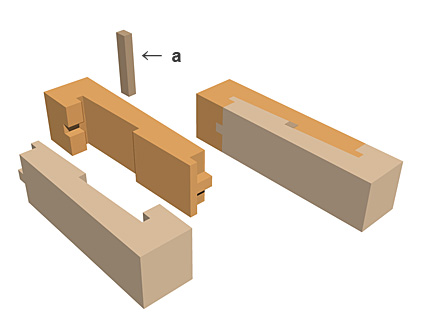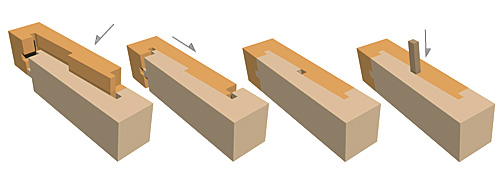|
||
 |
||

a) komisen 込栓

(C)2001 Japanese Architecture and Art Net Users System. No reproduction or republication without written permission.
掲載のテキスト・写真・イラストなど、全てのコンテンツの無断複製・転載を禁じます。
|
||||||
| kanawatsugi 金輪継 | ||||||
| KEY WORD : architecture / joints | ||||||
| An oblique,
housed (dadoed), rabbeted, T-shaped, half-blind, tenoned scarf joint. Because
both the tenon and mortise are blind, the joint cannot be slipped together
from the side, as in an oblique, housed, rabbeted, scarf joint *okkake
daisentsugi 追掛大栓継. The oblique surface on the mortised half of
the indented part is decreased by the depth of the rabbet. Therefore, the
end with the inverted T-tenon on the corresponding piece must be inserted
in a lengthwise direction. Then a joining draw pin komisen 込栓 (see *sen
栓) is driven through the opening provided in the center to lock the joints.
Sometimes two keys *shachi
車知 are used in place of a draw pin to strengthen the joint. This joint
is commonly used in foundation footings *dodai
土台, wall plates *daiwa
台輪, the beam used for the bottom tracks for sliding doors or window *shikigeta
敷桁, and in eave purlins *dashigeta
出桁. The improvement in carpenter's tools in the Edo period
made it possible to fashion complex joints such as this. |
||||||
|
a) komisen 込栓

|
||||||
| REFERENCES: | ||||||
| EXTERNAL LINKS: | ||||||
| NOTES: | ||||||
(C)2001 Japanese Architecture and Art Net Users System. No reproduction or republication without written permission. 掲載のテキスト・写真・イラストなど、全てのコンテンツの無断複製・転載を禁じます。 |
||||||